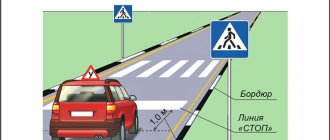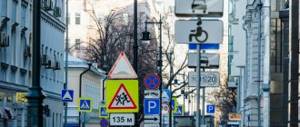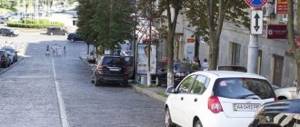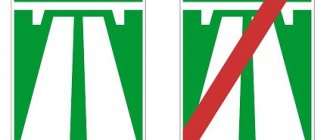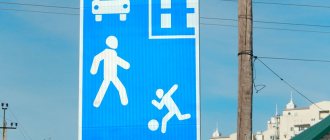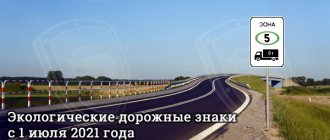These signs warn you that you are approaching:
| 1. | Towards a railway crossing without a barrier. |
| 2. | Towards a railway crossing with a barrier. |
| 3. | To the place of work on the road. |
The main sign “Railway crossing with barrier” outside populated areas is installed at a distance of 150 to 300 m before the crossing, in addition, the same sign is installed again at a distance of at least 50 m before the crossing.
“Approaching railroad crossing” signs provide additional warning that you are approaching a railroad crossing. They are used only outside populated areas.
Important information
In order to avoid an accident, the driver must be well versed in all traffic signs, including those installed in the railway area.
Basic information:
| First type sign | Installed in areas close to railway crossings. This sign warns of the presence of a barrier |
| Sign number 2 | Warns the driver about the absence of a barrier at the railway crossing |
| Road signs before railway crossings are installed twice | This is necessary in order to attract the driver's attention |
| First sign | Always located at a distance of 150 to 300 meters from the railway tracks |
| Second sign | Fixed at a distance of up to 50 meters. Approaching the railway, the driver initially falls within the coverage area of the first warning sign, and subsequently the second. |
| Warning sign in populated areas | Posted only once at a distance of up to 100 meters from the railway |
It is necessary to clearly know all types of signs - from 1.1 to 1.4 in order to accurately determine the type of railway crossing.
Photo: road signs close to the railway crossing
Initial data
Sign 1.1 railway crossing with a barrier is usually fixed at a remote distance in order to give the driver the opportunity to reduce the speed in advance.
There are also additional signs that give the driver an idea of the approach to the railway crossing.
The number of red lines tells the driver about the proximity to the railway - the fewer there are, the closer the railway crossing is.
A sign with three stripes is usually installed together with a sign of the first type, meaning that a “crossing with a barrier” is located in the distance.
Thus, a sign with three stripes is fixed at a distance of about 150 meters, with two stripes - at a distance of no more than 100 meters from the railway.
While in a certain zone, the driver must reduce speed to comply with established traffic standards.
Main types (adjustable)
A description of the operation of a controlled railway crossing will allow the driver to understand the principle of operation of the system and reduce the number of mistakes made when driving.
Driving in the wrong place or in violation of the rules is punishable under the Code of Administrative Offenses of the Russian Federation and a fine is imposed. It is possible to lose your driver's license for a certain period of time.
Railroad crossings can be divided into two types:
- Adjustable.
- Unregulated.
The first type of railway crossing, regulated, implies the presence of regulation of the movement process.
Such a crossing is equipped with several warning structures, color or sound signals, and a barrier. There may also be a duty booth at the crossing area.
At an unregulated crossing, none of the warning methods described above are available.
Warning signs should be located in several places, at different distances from the crossing, in order to ensure that the driver is likely to notice them.
The first warning sign or signal is installed at a distance of no more than 300 meters. Overtaking vehicles is strictly prohibited at a distance of 150 to 300 meters from the railway tracks.
Identification signs and warning signals will also be placed in this area.
What regulations governs
Regulatory legal acts regulating the process of movement in railway zones:
- Federal Law No. 257 - “On highways and road activities in the Russian Federation.” Additionally, changes are being made to other legislative acts. Particular attention is paid to Article 21 of Federal Law 257 – Crossing highways with railway tracks.
- Government Decree No. 1090 - Traffic Rules, additional document - the main provisions for admitting a vehicle to operation.
- Federal Law No. 17 - “On railway transport in the Russian Federation.”
- Federal Law No. 196 is a document containing requirements for ensuring road safety.
Each driver must not only familiarize himself with the texts of these regulations, but also comply with all requirements in order to avoid emergency situations on the road.
Can you outrun a tractor?
| 1. | No. |
| 2. | Yes. |
| 3. | Yes, if overtaking is completed 100 m before the crossing. |
Overtaking is prohibited at railway crossings and closer than 100 m in front of them. Since the railway crossing is located outside the populated area, the signs “Railway crossing without a barrier” and “Approaching a railway crossing” are installed at a distance of 150-300 m before the crossing. Therefore, you can start overtaking the tractor in this situation if the overtaking is completed 100 m before the crossing.
These signs warn you:
| 1. | About approaching a railway crossing with three tracks. |
| 2. | About the presence of a railway crossing without a barrier in 150-300 m. |
| 3. | About the presence of a railway crossing in 50-100 m. |
In front of you is a sign for a railway crossing without a barrier. The sign “Approaching a railway crossing” with three stripes installed underneath is only an additional warning about approaching the crossing. Outside populated areas, this combination of signs is installed at a distance of 150 to 300 m before the crossing.
Sign “Railway crossing”
Crossing a railway requires increased concentration from the driver. They can be non-adjustable or equipped with a barrier and additional warning signals; based on this, there are different road signs. The “Railway Crossing” road sign is installed immediately before the railway crossing.
List of signs
1.1 – “Moving with a barrier.” Behind a populated area, this designation is displayed at a distance of 150-300 meters. In populated areas - 50-100 meters. The sign means approaching a railway crossing without a barrier. Also at such a crossing there are additional notifications, such as: a sound signal, markings and metal obstacles blocking the crossing.
1.2 – “Moving without a barrier.” Behind a populated area such a sign is posted at a distance of 150-300 meters. In populated areas - 50-100 meters. It notifies you of the proximity of a railway crossing without a barrier.
1.3.1 – This sign is placed before a railway crossing with one track.
1.3.2 – Indicates that there will soon be an intersection of at least two paths.
Signs: 1.4.1 - 1.4.6 - notify how far away the intersection with the rails is. A symbol with a triple stripe is placed together with a sign “1.1” or “1.2”, the next one is placed separately, and the last one is again combined with “1.1” or “1.2” before moving.
The list of signs: 1.4.1 – 1.4.6 differs from each other in the direction of the lines, this is due to the fact that they are located on both sides of the roadway.
The railway crossing rules do not provide for:
Turn in the opposite direction;
move with the barrier down;
move when there is a flashing signal or sound warning.
10 m before the rail or 5 m before the lowered barrier;
to a traffic light or stop line.
Punishment
The moving rules are regulated by Article 12.10 of the Code of Administrative Offenses of the Russian Federation.
A fine of 1000 rubles or deprivation of rights for 3-6 months for stopping at an intersection or driving when the prohibition signals are turned on;
deprivation of rights for 1 year if these requirements are violated a second time.
All these signs are needed to inform the driver in a timely manner. This mainly concerns No. 1.2 (crossing without a barrier). Although these signs are available in all regulated places, accidents still occur to this day.
What signs are installed immediately before a railway crossing?
| 1. | Only A. |
| 2. | Only B. |
| 3. | Only in. |
| 4. | A and B. |
Answer
| Sign B “Multi-track railway” is installed closest to the railway crossing. It is placed in front of railway crossings without a barrier on the same support as traffic lights, and in their absence, at a distance of at least 20 m from the nearest rail. |
| Signs A “Railway crossing with a barrier” and “Approaching a railway crossing” are installed only on roads outside populated areas at a distance of at least 50 m from the dangerous area. |
| Signs B “Railway crossing without a barrier” and “Approaching a railway crossing”, respectively, 150-300 m before it. |
The correct answer is Only B.
Road signs in front of a railway crossing
Railroad accidents occur quite often today. As an example, in the coming year there have already been more than 250 incidents involving a train. Compared to the familiar highway accidents, this is, of course, small, but it is worth understanding that the collision in question leaves practically no chance for a person to survive.
Varieties
In practice, there are two types of railway crossings.
- One that is regulated. According to the rules, this type is equipped with a traffic light and a barrier. A person on duty is installed to monitor their work. Regarding traffic, such crossings are safer for people if we consider them from the point of view of the presence of warning signals. However, accidents often occur at such crossings.
- The move is not regulated. The railroad crossing road sign like a picture can be found in villages. They are considered less dangerous, since the road passes through the rails less often here. In addition, freight trains that do not have high speed often travel along such a road.
In places where there are tracks with fast locomotives moving along them carrying passengers, the first type of crossing is installed. This is due to the fact that during emergency braking, the composition can cause irreparable consequences for the life or health of the person in the car.
If a train collides with a passenger car at high speed, casualties in the passenger car cannot be avoided. This could be a woman or a man. However, this does not mean that an unregulated crossing can be ignored by the motorist. It is understood that a person should move through such a place with special vigilance. This mainly applies to night time.
Signs
A railway crossing sign is installed near such a crossing, and the icon indicates the designation of its type.
There are several options:
- there may be a single track in front;
- multi-track road.
If the tracks are single-track, this means that only one train can move on such rails, which goes in one direction. Such a road carries no less danger. When the train has passed, you can continue moving after you hear the permission signal.
A crossing road sign may indicate that there is a multi-track road ahead. This implies that composition can be expected from either side. The sign will warn of approaching trains. If the train has passed, but the prohibitory signal is still on, you should not move. Perhaps the train is moving from a different direction.
It should also be noted that a crossing sign is installed 200 meters or less before the crossing if we are not talking about a populated area. You need to pay attention to how many stripes are shown on the sign. Often such images are found in the coloring books of a child whose parents teach him safety from childhood.
When three stripes are drawn, this indicates that there are about 150 meters left to the tracks. Accordingly, 100 meters - two lanes and 50 - one. In photographs and in real life, the sign will look like a rectangular background with a red oblique line. Install it on the right side of the road.
For his safety, the driver must take into account the established rules at each interval of the roadway. According to GOST, it is stipulated that signs are also installed indicating that it is forbidden to move without stopping. This suggests that the driver must take the following action: stop the vehicle and make sure there are no trains.
When a train moves along the rails, you need to give way to it. In villages and other areas, most often, the stop does not last more than two minutes. This is due to the fact that during such a period of time the driver can fully assess the current situation and understand whether it is worth driving or not.
Without barrier
The acquaintance must take place and there is a railway crossing sign with a barrier. This sign indicates that there is a crossing ahead, which was not equipped with a barrier. Similar paths are installed in villages with a small population.
The installation is implemented twice:
- Initially at a distance of 300 to 150 meters. The distance to the crossing is indicated.
- Less than 50 meters from the tracks.
This setting is needed to warn a person who missed the first sign. It is understood that special care and attention will be required in this area. The agreed condition is that in urban areas the designations in question are installed extremely rarely. In the city, the sign is placed once - 50 or 100 meters before the tracks.
Outside the populated area - a double installation of the sign is required, which may be accompanied by additional symbols. For example, they install a traffic light, sound signals, etc. It is recommended to pay attention to multi-track roads that are not regulated. According to the photo, you need to make sure that there are no trains on all sides in this area, and then start moving.
With barrier
A railway crossing sign without or with a barrier is enshrined in the rules established according to road traffic. This sign can often be seen in photographs. The driver must automatically understand that he is talking about the location of the road ahead with a barrier. It is usually supplemented by signals or traffic lights.
- adjustment is carried out automatically;
- the person on duty can also control it.
In a populated area, installation is organized once. The specified permit is placed outside the city twice.
Distance
The size depends on the zone in which the sign is installed.
- If it refers to a populated area, then it is placed once. The distance must be at least 50 meters to the tracks.
- If outside the village, warnings are posted twice. The first time was 200 meters before the danger and the second time was 50 meters away.
You can download the rules for installing signs that reflect the dependencies on the type of crossing. If we talk about adjustable crossings, then they install it 2 or 3 meters before the barrier. If there is an unregulated crossing ahead, then the installation is carried out at a similar distance from the last sign.
Rules
You should also become familiar with the rules regarding moving.
It is necessary to understand the basic rules established regarding the signs in question:
- It is prohibited to stop at crossings;
- when there is a traffic jam behind the tracks, you cannot cross them;
- It is prohibited to organize parking closer than 50 meters to the tracks.
Motorists must understand that they cannot stop at crossings even for a short period of time, not to mention parking. Attention should be paid to the rules that indicate forced stops at crossings. This assumes that the stop was implemented through no fault of the driver. For example, a car has a malfunction. The car could also make an emergency stop, causing the car to stop on the rails.
In such a situation, rules apply that indicate the need to remove all passengers from the car and take them away from the rails for their safety. Next, one person is sent in both directions in order to be able to inform the train driver that the tracks are not clear. To do this, you need to pick up a flashlight or a rag and wave them.
You are also required to stay near the car at all times and sound alarms. If the train appears in the visibility zone, you need to run towards it and give signals. It should be taken into account that you should not move along the rails, but next to them. The duty officer should be made aware of what is happening. If these rules are not followed, the perpetrator faces punishment from the traffic police. There may also be an accident where people get hurt.
STOP sign
Some people believe in dream books and zodiac signs, however, this cannot be done in the situation under consideration. If the driver sees a stop sign, he needs to turn off the engine and make sure that it is safe to continue driving. This sign is placed near the tracks. However, it always has this designation.
- If the crossing is not regulated, you need to stop the car and make sure it is safe to move. All directions should be examined.
- If the stop is not made, it is a violation of the rules.
In a situation where there is a controlled crossing ahead, the stop sign does not have a decisive meaning. This is due to the fact that attention is paid to the traffic light. When the red light is on, you must stop the car. When there is no such signal, there is no need to stop.
When the traffic light is on
Traffic rules indicate:
- when the barrier is lowered or has already lowered, you cannot enter the crossing;
- if the red signal is on, you cannot drive onto the rails in any case, no attention is paid to the barrier here;
- when the duty officer gives a special signal, you cannot enter the rails;
- Different signals are not taken into account if a train is approaching a crossing.
In addition, you need to remember about the prohibitions on overtaking a vehicle that is moving in front, while entering the lane for oncoming traffic. Even if the train is not in sight, you cannot open barriers in the form of barriers yourself, and you should not use the crossing to transport special equipment. To move on the device’s rails at a speed of less than 8 kilometers per hour, you must obtain the consent of the person on duty.
Fines
It should be noted that penalties have been established for the violations in question.
- When the barrier is lowered, the red lights are on, or unidentified crossing areas are used, the fine is one thousand rubles. They may also be deprived of their rights for a period of three to six months.
- Stopping in unauthorized places is not allowed. The driver is fined one thousand.
- If you do not stop at a sign requiring a stop, you will be deprived of your license for a year.
- If overtaking occurs in oncoming traffic, the fine is 2.5 thousand rubles.
It is worth pointing out that the most severe punishment is a traffic accident. This is due to the fact that the car turns into wreckage. If there are people in the car, then they have very little chance of surviving. For this reason, it is recommended to comply with the rules prescribed by the legislator.
In particular, before moving, several types of signs are placed, which have the function of warning that there is danger ahead. These designations are studied in sufficient detail in a driving school. When a future driver takes an exam, such knowledge is tested orally. By studying the signs, you can not only avoid punishment, but also save the lives of yourself and those other than the driver in the car.
You should always understand that on regular highways a car has the ability to stop suddenly or give way to another vehicle. If we talk about trains, then this will not be possible. Therefore, you need to control what is happening when the rails are located in front.
Which driver violated the parking rules?
| 1. | Both did not violate. |
| 2. | Both violated. |
| 3. | Only the driver of car B. |
| 4. | Only the driver of car A. |
Both drivers violated the Rules, since parking is prohibited within 50 m on either side of railway crossings.
Is such a maneuver allowed?
| 1. | No. |
| 2. | Yes, if there are no oncoming vehicles. |
| 3. | Yes, if the distance between the barrier and a stopped truck is 6 m. |
The driver of the truck stopped in accordance with the requirements of the Rules - no closer than 5 meters from the barrier, and passing vehicles standing in front of the crossing into oncoming traffic is prohibited.
Stop at a crossing
Stopping at a railway crossing threatens the health and life of the driver and passengers. If this happens for technical reasons , two passengers in the car are poisoned on both sides of the tracks .
When a train approaches, they must give signals to the driver . The driver must take all possible measures to remove the vehicle from the tracks. Railroad crossings have special stop lines and STOP signs that you must stop in front of .
If the crossing is not equipped with a barrier , you must stop before the STOP sign , make sure that further movement is safe , and only then continue on your way . If there are no signs or lines at the crossing, then the stop is made in front of the railway crossing 5 meters from the barrier or 10 meters from the nearest rail .
The fine for stopping at a railway crossing is 1,000 rubles or
deprivation of a driver’s license for a period of 3 to 6 months . The fine for crossing a stop line and a STOP sign at a crossing is 500 rubles .
It is not prohibited to overtake and avoid stationary obstacles that are located in the traffic lane (for example, construction material, garbage, etc.).
Here you will find out the latest news about possible changes in the amount of the fine for illegal movement through the railway. moving.
